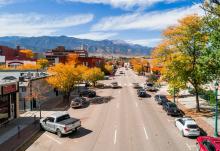 Key Trends and Assumptions
Key Trends and Assumptions

The following trends and assumptions provide a quick overview of some of the high-level issues related to Majestic Landscapes. They are intended to provide a baseline understanding of emerging trends, preferences, and opportunities that may affect how Colorado Springs will grow and change in the coming years. This foundation sets up PlanCOS to provide tailored policy direction and implementation strategies. More background information can be found in Appendix A: State of the City Snapshots.
- Colorado Springs is known as a top city for outdoor recreation with access to over 17,000 acres of parks and open space.
- Colorado Springs residents are “ultra-users” of park and open space facilities and the per-capita use rates for these facilities are twice those of similar communities.
- Although the demand for particular facilities and activities within our green infrastructure system is expected to fluctuate in response to changes in demographics and recreational behavior, overall demand is projected to increase in response to our growing population.
- Despite the relative popularity of our parks and open spaces, the City of Colorado Springs has a limited parks and recreation budget, compared with other cities. Continued under-funding of these critical assets diminishes the health, resilience, beauty, and value of our built environment which has increasingly negative impacts on property values, tax revenues, quality of life, and water quality.
- There are numerous benefits of a park, streetscapes, and open space network that are both directly and indirectly quantifiable. Proximity to parks increases property values and subsequently property tax; residents of Colorado Springs have saved millions of dollars in medical care costs annually by using the parks and recreation system amenities for exercise; time spent in parks and open spaces can help individuals fight against mental health issues like depression, anxiety, and stress; and the natural cleansing of air and stormwater by landscapes and vegetation reduces stormwater and air quality mitigation costs.
- Not only do parks, streetscapes, and open spaces play a major role in the city’s and the state’s tourism economy, but access to and availability of parks and recreational opportunities has become one of the primary reasons an individual chooses to live or locate their business in Colorado Springs. Prospective residents and employers are attracted to locations that offer these amenities and value their care.
- Street trees provide shade, make streets more walkable and bikeable, and lower the average electricity and water bills of surrounding households; they lower the average driving speed, making roadways safer for pedestrians and drivers; they improve the health of nearby residents, lower crime rates, and drastically increase property values in an area.
- Diversification of the urban forest is critically important to mitigate the impacts of insect infestations, drought, and other sources of tree decline. Declining tree health in parks, streetscapes, and other public rights-of-way will further cost the City of Colorado Springs and its citizens as these are the responsibility of the City to maintain. This is also the case with the invasion of noxious weed and tree species in open spaces and rights-of-way.
- Many man-made landscapes in Colorado Springs are currently in decline. The City of Colorado Springs has an important role to play in demonstrating the value and importance of the built landscape as this supports and enhances the stewardship and appreciation of our majestic natural landscapes.
Landscape Typologies and Framework
Our Majestic Landscape typologies are intended to highlight the important and varied natural landscapes within our city. They span a whole range of sizes, from mini parks to federal and state lands, and can encompass a range of recreational activities, from group sports to hiking or picnicking. Additionally, our city’s green infrastructure provides an essential system of connections, waterways, and corridors that serve a variety of purposes.
The city is connected by creeks, streams, ditches and other water channels that carry surface water flows as well as increased stormwater run-off. Creek corridors and greenways offer a green network that connects our city from north-to-south and from east-to-west. Creeks connect us with off-street trails, provide living classrooms, and provide relaxing spaces.
Common Desired Elements
- A design that is functional, sustainable, and provides for public safety, flood hazard mitigation, and maintenance of all associated facilities;
- Community focal points for open space and recreation;
- A design and pattern that allows water to slow down, spread out, and soak in to reduce erosion potential;
- Amenities for park and recreation users;
- Attention to Americans with Disabilities Act (ADA)-accessibility and Universal Design;
- Preservation of and creation of additional important native habitat and natural systems within and surrounding the city;
- A culture of environmental stewardship; and
- Flexibility and adaptability in our park and trail system design as the way we use our parks changes.
Majestic Landscape typologies are as follows:
- Neighborhood Greenspaces
- Sports and Active Recreation
- Natural Resources and Regional Recreation
- Community Education Landscapes
- Greenways
- Trails and Connectors
- Complete Urban Creeks
- Complete Greenways
